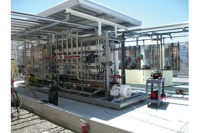Market Insights: Successfully driving a project
In today’s marketplace, with manufacturers focusing on getting their product to their customers as soon as possible, speed and efficiency are critical to a project’s design and construction phases. Design/build is often an attractive way to meet a condensed schedule. Cost is another key factor and design/build promotes the ability to link design to construction and minimize change orders.
However, design/build can be laden with immense risk if inexperienced players and a poorly defined scope drive the project. Mitigating risk is possible with a proper focus on scope, schedule and budget. With design/build’s approach of one entity being responsible for integrating all steps in the process, the project can be viewed as a whole, which promotes a greater understanding of the true critical paths.
The bigger the project and the more stake-holders involved, the larger the risk. Project organization and experience matter to the design/build firm’s client.
Scope is key
Adequate time spent accurately defining the project scope may be the single most important factor in reducing risk. Since the project will be proceeding without the benefit of a full design, the risk resides in the unknown. Key aspects of the project that need to be raised in preliminary discussions are:
- Project expectations – Define the project goals and deadlines.
- Design basis documents – Establish the framework for the entire project to achieve the project expectations.
- Existing conditions – Provide a clear under-standing of the site’s field conditions and any actions that need to be taken to prepare the site. This attention to site details is essential to minimize unexpected construction costs.
- Utility infrastructure – Determine if the existing facility has the power, air, water, HVAC and gas requirements needed to support the manufacturing process.
- Project acceptance –List the steps necessary for the hiring firm to deem the project complete.
Developing a schedule
Delays and problems will arise that will challenge the project schedule. To be prepared, it is essential to spend time with the project team to develop the steps and interactions needed to achieve project goals. Here are some key considerations:
- Couple key project items (e.g., packaging, processing, utilities, building expansion and wastewater design). This will allow critical project milestones to be integrated efficiently.
- ï€ Optimize the schedule by reducing the lag time between key phases (e.g., packaging concept and impacts to the building). This is done by integrating project work staff and improving interactions within the project team.
- Understand the potential critical path issues, such as equipment deliveries and production downtime windows to minimize and control the critical path.
However, design/build can be laden with immense risk if inexperienced players and a poorly defined scope drive the project. Mitigating risk is possible with a proper focus on scope, schedule and budget. With design/build’s approach of one entity being responsible for integrating all steps in the process, the project can be viewed as a whole, which promotes a greater understanding of the true critical paths.
The bigger the project and the more stake-holders involved, the larger the risk. Project organization and experience matter to the design/build firm’s client.
Scope is key
Adequate time spent accurately defining the project scope may be the single most important factor in reducing risk. Since the project will be proceeding without the benefit of a full design, the risk resides in the unknown. Key aspects of the project that need to be raised in preliminary discussions are:
- Project expectations – Define the project goals and deadlines.
- Design basis documents – Establish the framework for the entire project to achieve the project expectations.
- Existing conditions – Provide a clear under-standing of the site’s field conditions and any actions that need to be taken to prepare the site. This attention to site details is essential to minimize unexpected construction costs.
- Utility infrastructure – Determine if the existing facility has the power, air, water, HVAC and gas requirements needed to support the manufacturing process.
- Project acceptance –List the steps necessary for the hiring firm to deem the project complete.
Developing a schedule
Delays and problems will arise that will challenge the project schedule. To be prepared, it is essential to spend time with the project team to develop the steps and interactions needed to achieve project goals. Here are some key considerations:
- Couple key project items (e.g., packaging, processing, utilities, building expansion and wastewater design). This will allow critical project milestones to be integrated efficiently.
- ï€ Optimize the schedule by reducing the lag time between key phases (e.g., packaging concept and impacts to the building). This is done by integrating project work staff and improving interactions within the project team.
- Understand the potential critical path issues, such as equipment deliveries and production downtime windows to minimize and control the critical path.
- ï€ Plan the sequence of construction in detail to understand and avoid constructability issues that could inflate the construction price.
- ï€ Develop a commissioning plan that will allow for commissioning critical items, such as air compressors for manufacturing equipment, prior to manufacturing startup.
- ï€ Communicate the schedule to all stakeholders to achieve buy-in and consensus.
Importance of the contract
Project cost development is best done by an experienced design/build team of designers, equipment suppliers and contractors. The team’s collective experience adds to the understanding of the potential pitfalls of the project and associated cost implications.
The final contract between the design/build firm and manufacturer is often an overlooked document until the very end of the scope, schedule and budget discussions. However, this document is very important in protecting both parties’ interests if the project does not proceed as expected. Safety, insurance and bonding concerns need to be addressed upfront. Project termination procedures, intellectual property and payment terms can often become a roadblock to final contract acceptance. Design/build firms experienced in this type of contracting can often guide the hiring firm through the legal process.
The bottom line is that the only way to proceed with a design/build project is by working with an experienced supplier. That experience guides a project through the process by knowing which suppliers to turn to, understanding the typical obstacles that will need to be overcome and how to overcome those obstacles. BI
- ï€ Develop a commissioning plan that will allow for commissioning critical items, such as air compressors for manufacturing equipment, prior to manufacturing startup.
- ï€ Communicate the schedule to all stakeholders to achieve buy-in and consensus.
Importance of the contract
Project cost development is best done by an experienced design/build team of designers, equipment suppliers and contractors. The team’s collective experience adds to the understanding of the potential pitfalls of the project and associated cost implications.
The final contract between the design/build firm and manufacturer is often an overlooked document until the very end of the scope, schedule and budget discussions. However, this document is very important in protecting both parties’ interests if the project does not proceed as expected. Safety, insurance and bonding concerns need to be addressed upfront. Project termination procedures, intellectual property and payment terms can often become a roadblock to final contract acceptance. Design/build firms experienced in this type of contracting can often guide the hiring firm through the legal process.
The bottom line is that the only way to proceed with a design/build project is by working with an experienced supplier. That experience guides a project through the process by knowing which suppliers to turn to, understanding the typical obstacles that will need to be overcome and how to overcome those obstacles. BI
Looking for a reprint of this article?
From high-res PDFs to custom plaques, order your copy today!




